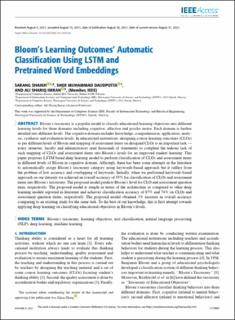| dc.description.abstract | Bloom’s taxonomy is a popular model to classify educational learning objectives into different learning levels for three domains including cognitive, affective and psycho motor. Each domain is further detailed into different levels. The cognitive domain includes knowledge, comprehension, application, analysis, synthesis and evaluation levels. In educational institutions, designing course learning outcomes (CLOs) as per different levels of Bloom and mapping of assessment items on designed CLOs is an important task — every semester, faculty and administrators read thousands of statements to complete the tedious task of such mapping of CLOs and assessment items into Bloom’s levels for an improved student learning. This paper proposes LSTM based deep learning model to perform classification of CLOs and assessment items in different levels of Bloom in cognitive domain. Although, there has been some attempts in the literature to automatically assign Bloom’s taxonomy category using keywords-based approach but it suffers from the problem of low accuracy and overlapping of keywords. Initially, when we performed keywords-based approach on our datasets we achieved an overall accuracy of 55% for classification of CLOs and assessment items into Bloom’s taxonomy. The proposed model predicts Bloom’s level for CLO and assessment question item, respectively. The proposed model is simple in terms of the architecture as compared to other deep learning models reported in literature and achieves classification accuracy of 87% and 74% on CLOs and assessment question items, respectively. The proposed model obtained 3% increase in overall accuracy comparing to an existing study for the same task. To the best of our knowledge, this is first attempt towards applying deep learning on classifying educational objectives in Bloom’s levels. | en_US |

